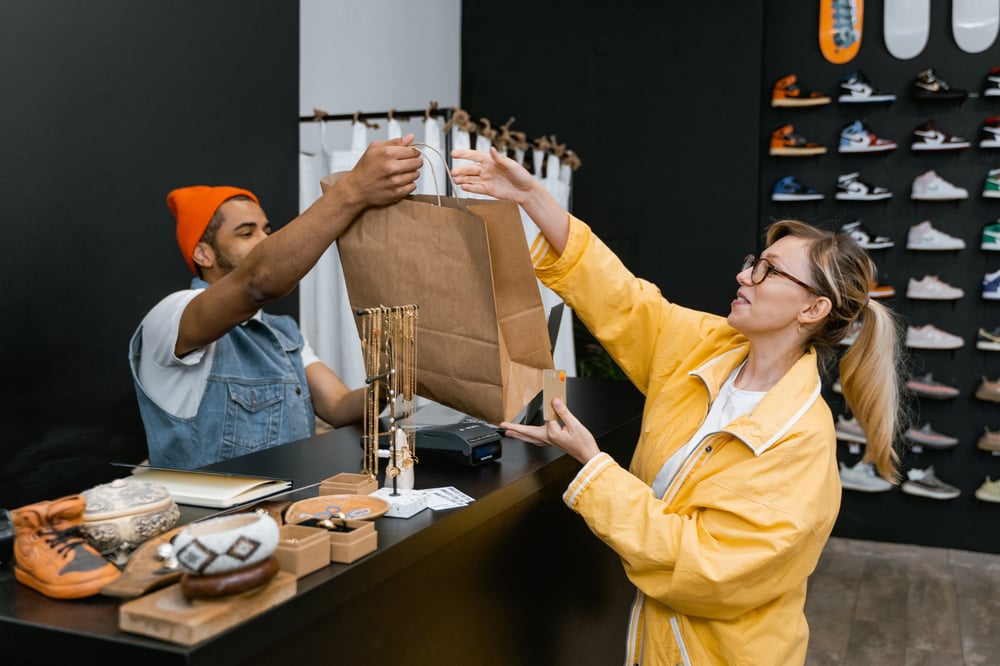Retail’s recent evolution hasn’t changed the fact that the customer experience is everything. However, what constitutes a good or bad customer experience continues to evolve alongside shifting consumer expectations. Today’s customers value employee expertise, progressive technology, and an emotional connection.
Despite this, many retailers fail to meet the expectations of the modern consumer and roll out an inadequate customer experience riddled with mistakes.
The good news is that it can be fixed. Keep reading to find out what makes a bad customer experience and how to correct the mistakes that are detrimental to your business.
Quick navigation:
- What makes a bad customer experience?
- Why is customer experience so important?
- 6 examples of bad customer experience and how to avoid them
↳ Long wait times
↳ Negative attitude or tone
↳ Passing customers from one colleague to another
↳ Lack of empathy
↳Outdated technology
↳ Poor knowledge of products and services

What makes a bad customer experience?
After speaking to 2000 consumers, one study concluded that the leading causes of a bad customer experience were long wait times (51%), unhelpful staff (44.7%), unavailable stock (43.1%), lack of available staff (38.9%), and store design (14.6%).
Looking at the list, there’s not a problem on there that isn’t easily fixed. Yet, retailers are repeatedly plagued by the same issues. This can be attributed to the customer experience gap, a term used to describe the disconnect between the brand’s and the customer's perception of the experience. One study revealed that 80% of organizations believe they’re providing a superior customer experience, while only 8% of customers agreed.
The first step to solving any problem is admitting you have one. It’s important businesses objectively evaluate their customer experience and determine what needs to change.
Why is customer experience so important in retail?
Retail is a customer-centric industry where the consumer determines your success. This is reflected at the highest level, with 90% of CEOs listing the customer as having the greatest impact on their business.
Let’s take a closer look at exactly how the customer experience influences success:
1. Separates you from your competition
It’s becoming increasingly difficult to stand out in the retail industry, with organizations stocking the same products at almost identical price points. Customer experience is where you can show what makes you special. In fact, 39% of CEOs listed customer experience as the best way to create a competitive advantage.
2. Leads to growth
It’s common sense that the more satisfied the customer, the more your business will grow. But just how significant CX is to a retailer's growth might surprise you. Brands with outstanding customer experience generate 5.7 times more revenue than their competitors.
3. Improves customer retention
If you’re not prioritizing customer retention, then you need to reconsider. A 2% improvement in customer retention equals the same amount of profit as cutting costs by 10%. This is because a returning consumer is up to 10x more profitable than a new one. And customer experience determines brand loyalty—1 in 3 customers will leave a brand they love after just one bad experience.
4. Increased employee engagement
Valuing the customer experience not only benefits your customers but your workforce too. Companies with initiatives to improve CX see employee engagement increase by 20% which, in turn, helps them outperform the competition by 147%.

6 examples of bad customer experience and how to avoid them
We’ve briefly touched on the main reasons for bad customer experience. Now we’re going to show you several key examples, and how to avoid them.
1. Long wait times
Long wait times were listed as the number one reason consumers abandon a purchase. And while queuing can be utilized to increase sales, extended waiting times drive valuable consumers away.
The cause
So, what causes long wait times? Unfortunately, it’s rarely because your store and products are simply that popular. Instead, it comes down to a poorly trained workforce and a lack of practical technology.
Salespeople are responsible for a range of tasks that pull them all over the store. One minute they could be optimizing an in-store display, the next they’re completing inventory checks in the backroom. Other tasks are therefore prioritized over the customer, which is the worst possible outcome for the customer-centric retail industry.
Other factoring causes include a customer demand that’s too high for your workforce to manage and outdated technology that hinders service instead of helping.
How to fix it
Start with your workforce and implement refresher training that reinforces the importance of the customer. Somewhere along the way, employees started to value other business areas over the customer, and, while all store operations are important, your customers are your most precious commodity.
Additionally, train staff on how to better manage their time. For example, in-store displays should be optimized during the quietest hours, rather than when the store is at its busiest.
Once your workforce is re-trained and ready to go, evaluate what else could help. Invest in queue management technology—such as self service kiosks—to reduce wait times, and increase the size of your workforce to match your growing customer demands.
2. Negative tone/poor attitude
As the expression goes, ‘ it’s not what you say, it’s how you say it.’
For customers, it’s not just about solving their problems—how you interact with them is equally as important.
We know communication is all-encompassing, and that words, body language, and tone all play a part in getting the message across.
The cause
The first place to look is training. Product knowledge usually takes center stage during retail training, while customer interaction is sometimes overlooked.
Another cause could be personal. Tone and attitude are closely linked to mood and well-being, and everyone experiences their bad days. It’s when behavior consistently becomes a problem that managers should grow concerned.
How to fix it
Consider talking to employees who are repeat offenders and see if they need any additional support, both professional and personal. Prioritizing your staff’s well-being goes a long way toward improving service - the happier your staff are in their roles, the more motivated they will be to go above and beyond for your customers.
Another way to improve your employees' interactions with customers is through training. Highlight the importance of supplementing information with a friendly demeanor and positive body language. Role-play and immersive scenario-based training is also an incredibly effective training tool to prepare workers for a wide range of customer interactions.
Here's an example of a lesson using eduMe's immersive Scenario Videos feature 👇
3. Passing customers from one colleague to another
We’ve all experienced this at some point. The first colleague is unable to provide an answer so they pass us on to someone else, rather than proactively finding the answer themselves.
Such behavior only helps perpetuate the widely held belief that retail associates lack expertise, highlighted by the fact that 83% of customers think they know more than the retail workforce.
The cause
A major cause is poor onboarding. Often these scenarios happen when the retail worker is brand new and doesn’t possess the necessary knowledge, resulting in them having to ask a colleague for help and leave the customer frustrated.
The onboarding process is difficult to get right. However, if you don’t, you end up sending out new recruits onto the shop floor unprepared to serve your customers properly. Not only does this result in a lost sales opportunity and a poor experience, but it also disillusions the worker and increases the risk of churn.
How to fix it
Optimize your onboarding. It’s all about putting your new workers in a position to succeed by providing them with everything they need to effectively serve your customer. Leverage mobile-friendly onboarding to ensure that they always have access to the information they need, and can quickly brush up on new skills on-the-job.
VR experiences are also a great way to familiarize new recruits with the store layout before they’ve even arrived for their first shift, meaning they can hit the ground running and feel more confident from day one.
Here's an example of a VR walkthrough lesson you could create with eduMe 👇
4. Lack of empathy and listening skills
Empathy is the ability to understand the feelings of another. In retail, it’s about putting yourself in the customer’s shoes to better grasp their issue and come up with a solution. Two thirds of UK consumers now expect brands to act with empathy, proving just how valued this humanistic approach is. Failing to treat the customer as a human, and instead reducing them to a problem, can quickly drive them away.
And while listening doesn’t seem all that difficult, we are all guilty of zoning out from time to time, or rushing an interaction we’re not that invested in.
In retail, employees require an active listening approach that includes decoding messages to understand problems and picking up on both verbal and nonverbal cues. It’s a level up from the type of listening we experience in day-to-day life.
The cause
Empathy and listening are both skills and can therefore be taught. This is often overlooked because we don’t typically consider our emotions and senses as something that can be improved upon.
However, emotional intelligence training is now commonplace among the biggest companies—75% of Fortune 500 companies use emotional intelligence training tools. And businesses that score highly on customer experience often incorporate listening into their employee training.
How to fix it
Provide your team with education around empathy, asking them to uncover the needs of the consumer and build trust.
The same applies to listening. Teach them the components of active listening, including the importance of body language, decoding verbal messages, and paraphrasing consumers to show they were listening.
Role play is a great way of fine-tuning an employee's emotional intelligence and communication skills, as it mimics real-life scenarios.
Here's an example of an eduMe lesson on handling difficult customer interactions 👇
5. Outdated technology
When used correctly, technology can significantly enhance the customer experience. But many retailers employ legacy tech that has the opposite effect, and 47% of CX managers view outdated technology as their biggest barrier to providing the promised customer experience.
The cause
When retailers utilize technology that hinders their workers, it’s because they have failed to understand their specific needs.
Retail employees are always on their feet, dealing with customers in real-time. They’re only effective when they’re on the shop floor, and require immediate access to information so they can better serve the consumer. Retail technology doesn’t always cater to this, with classroom training and desktop databases pulling workers off the shop floor and limiting their access to information at the time of need.
How to fix it
Invest in technology that’s tailored to your workforce. Tablets are a great tool as your team can carry them around and access information when they need it most, without disrupting the flow of work.
You can also maximize your employees' time on the shop floor by automating manual tasks that aren’t vital to their role. Technology should do two things: keep your workers on the shop floor and assist them while they’re there.
6. Poor knowledge of products and services
Knowledge of the products and services your brand offers is the foundation of every customer experience. You could be a great listener with bags of empathy and a fantastic attitude, but it’s moot if you can’t solve the customer’s problem.
An increase in sales is indicative of a great customer experience, as the more satisfied the consumer is, the likelier they are to purchase. And retail associates with strong brand expertise sell 87% more than those without. The connection between poor product knowledge and a bad customer experience couldn’t be clearer.
The cause
The major causes are a lack of training and/or ineffective training. We’ve already touched on retail’s problem of failing to train its workforce. Employees can’t possess knowledge if they’re never taught it.
Ineffective training is a problem that’s just as widespread. Retailers continue to roll out long-format classroom training that fails to promote engagement and knowledge retention. In fact, 1 in 3 employees say their training is out of date.
Additionally, this style of training is incredibly time-consuming to create and brands aren’t able to roll out training quickly enough every time they have a new product launch. Workers are therefore unprepared to assist customers, leading to a poor experience.
How to fix it
Employ effective training that’s tailored toward the modern retail worker—someone who is constantly on the move and serving customers. Accessible via a smartphone, mobile training allows your sales associates to quickly brush up on product knowledge with short, bite-size lessons that are designed to drive engagement and knowledge retention.
This kind of training isn’t just quick to complete, it’s also extremely efficient to create. Brands can churn out new product training in a matter of minutes and deliver it to specific teams in a matter of seconds. Employees are more knowledgeable about the products they’re selling, leading to a better experience for customers.
Here's an example of eduMe's short form, social-media-style Guides designed to keep employees up to date on the latest processes and products 👇
Looking for a way to improve your customer experience?
We may be biased, but effective training is the key to growing a knowledgeable, empathetic and well-organized sales team that's ready to provide an exceptional experience for your customers.
Companies that have optimized their training offering with eduMe have seen a 10% increase in customer ratings, as well as a 66% increase in sales in just 3 months.
If you want to leverage this kind of training, but don't know where to start, why not try one of our free, editable course templates? 👇








